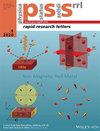通过原子层沉积原位 N2 等离子体和退火后辅助钝化实现 p-GaN 蚀刻诱导的性能恢复
IF 2
4区 物理与天体物理
Q3 MATERIALS SCIENCE, MULTIDISCIPLINARY
引用次数: 0
摘要
对氮化镓的蚀刻需要对蚀刻深度和形态进行极其严格的控制,否则会导致电气特性变差。这项研究利用 ALD(原子层沉积)原位 N2 等离子体和退火后辅助钝化技术,有效地恢复了因 p-GaN 刻蚀而退化的电气特性。与未钝化器件相比,这种方法消除了表面氧键,使漏极电流从 10 mA mm-1 恢复到 126 mA mm-1,栅极漏电流降低了一个数量级,导通/关断电流比超过 108,在 1 μA mm-1 时击穿电压达到 930 V,并有效抑制了电流塌陷。本文章由计算机程序翻译,如有差异,请以英文原文为准。
Performance Recovery of p‐GaN Etch‐Induced Degradation via Atomic Layer Deposition In Situ N2 Plasma and Postanneal‐Assisted Passivation
The etching of p‐GaN requires extremely strict control over etching depth and morphology; otherwise, it will result in poor electrical characteristics. This work uses ALD(Atomic layer deposition) in situ N2 plasma and postanneal‐assisted passivation to effectively recover the electrical properties degraded by p‐GaN etching. Compared to unpassivated devices, this approach eliminates surface oxygen bonds, recovering drain current from 10 to 126 mA mm−1 , reducing gate leakage by an order of magnitude, achieving an ON/OFF current ratio exceeding 108 , a breakdown voltage of 930 V at 1 μA mm−1 , and effectively suppressing current collapse.
求助全文
通过发布文献求助,成功后即可免费获取论文全文。
去求助
来源期刊

Physica Status Solidi-Rapid Research Letters
物理-材料科学:综合
CiteScore
5.20
自引率
3.60%
发文量
208
审稿时长
1.4 months
期刊介绍:
Physica status solidi (RRL) - Rapid Research Letters was designed to offer extremely fast publication times and is currently one of the fastest double peer-reviewed publication media in solid state and materials physics. Average times are 11 days from submission to first editorial decision, and 12 days from acceptance to online publication. It communicates important findings with a high degree of novelty and need for express publication, as well as other results of immediate interest to the solid-state physics and materials science community. Published Letters require approval by at least two independent reviewers.
The journal covers topics such as preparation, structure and simulation of advanced materials, theoretical and experimental investigations of the atomistic and electronic structure, optical, magnetic, superconducting, ferroelectric and other properties of solids, nanostructures and low-dimensional systems as well as device applications. Rapid Research Letters particularly invites papers from interdisciplinary and emerging new areas of research.
 求助内容:
求助内容: 应助结果提醒方式:
应助结果提醒方式:


